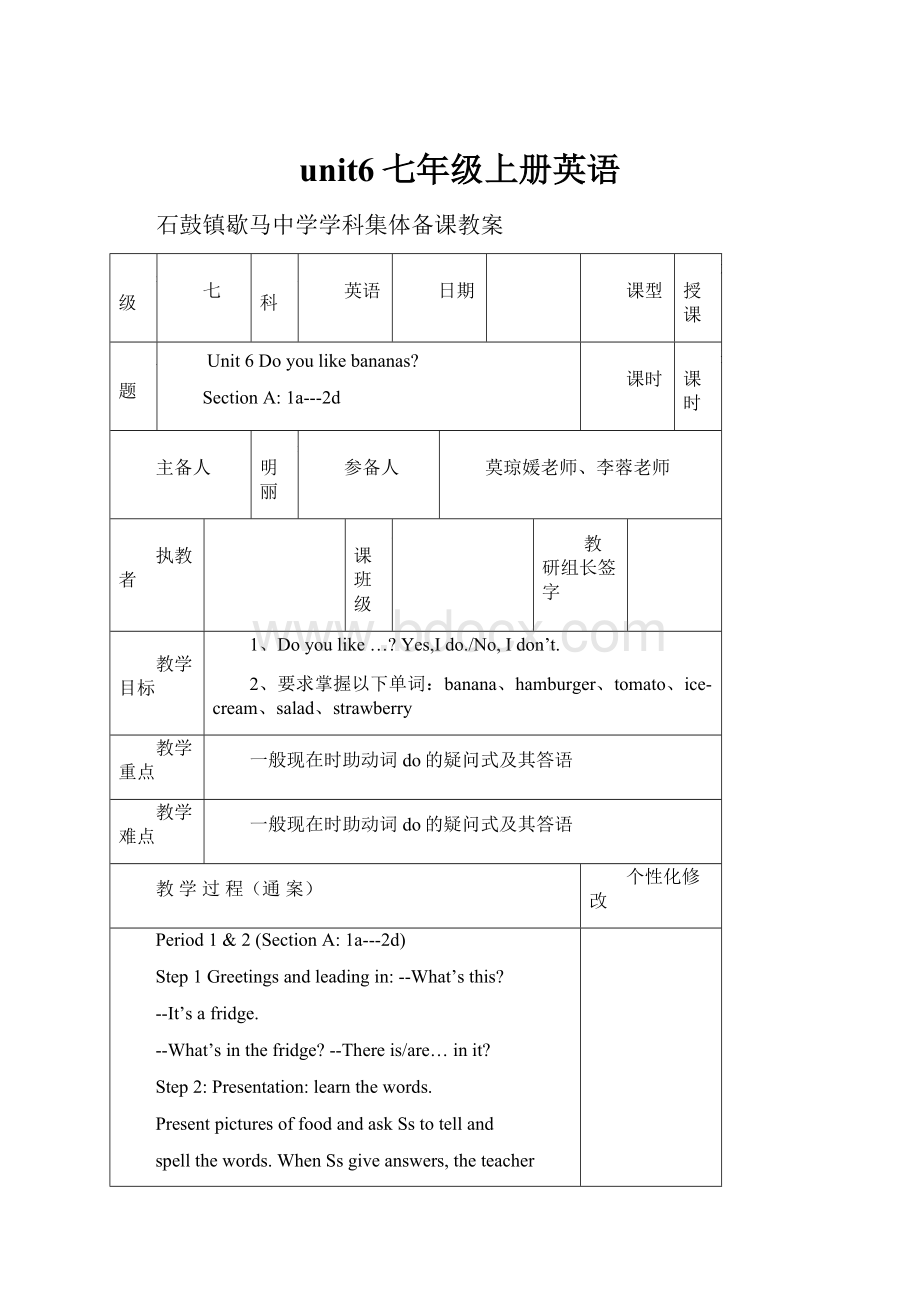unit6七年级上册英语.docx
《unit6七年级上册英语.docx》由会员分享,可在线阅读,更多相关《unit6七年级上册英语.docx(11页珍藏版)》请在冰豆网上搜索。

unit6七年级上册英语
石鼓镇歇马中学学科集体备课教案
年级
七
学科
英语
日期
课型
新授课
课题
Unit6Doyoulikebananas?
SectionA:
1a---2d
课时
共课时
主备人
莫明丽
参备人
莫琼媛老师、李蓉老师
执教者
上课班级
教研组长签字
教学目标
1、Doyoulike…?
Yes,Ido./No,Idon’t.
2、要求掌握以下单词:
banana、hamburger、tomato、ice-cream、salad、strawberry
教学重点
一般现在时助动词do的疑问式及其答语
教学难点
一般现在时助动词do的疑问式及其答语
教学过程(通案)
个性化修改
Period1&2(SectionA:
1a---2d)
Step1Greetingsandleadingin:
--What’sthis?
--It’safridge.
--What’sinthefridge?
--Thereis/are…init?
Step2:
Presentation:
learnthewords.
PresentpicturesoffoodandaskSstotelland
spellthewords.WhenSsgiveanswers,theteacher
writesthewordsdown.
T:
Let’splayagametotestyourmemory.Let’s
seewhohasagoodmemory.Whocantellwhatthey
are?
Ss…
T:
HowtospellitinEnglish?
Ss…
Step3:
Presentation:
learnthenewdrills.
A:
Doyoulikeapples?
B:
Yes,Ido.Ilikeapples.
B:
No,Idon’t.Idon’tlikeapples.……
Step4Workon1a
Step5Workon1bListeningpractice
Step6Workon1cPracticethetargetsentence
patternanditsanswers.A:
Doyoulikehamburgers
?
B:
Yes,Ido./No,Idon’t.A:
Doyoulikesalad?
B:
Yes,Ido./No,Idon’t.…
Step7Workon2aand2bListenandpractice.
Listento2aand2b.Payattentiontosentencepattern
―Doyoulike…?
‖―Yes,Ido.‖―No,Idon’t./
No,Idon’tlike…‖.Add―No,Idon’tlike…‖
onthebb.Step8Workon2cPracticetheconversationsa
bove.Doyoulikehamburgers?
No,Idon’t.
Doyoulikeice-cream?
Yes,Ido.……
Step8Exercises:
Homework:
Makeaninterviewtoyourfamilyaboutthefoodandfruit.Findoutaboutwhattheylike
anddon’tlike.Thenwritealetter.
板书设计:
教学反思:
石鼓镇歇马中学学科集体备课教案
年级
七
学科
英语
日期
课型
新授课
课题
Unit6Doyoulikebananas?
SectionA:
3a---3candGrammarfocus
课时
共课时
主备人
莫明丽
参备人
莫琼媛老师、李蓉老师
执教者
上课班级
教研组长签字
教学目标
1、Knowledgeobjects
2、Abilityobjects
教学重点
TargetLanguage.
教学难点
TrainSslisteningandcommunicativeskills.
教学过程(通案)
个性化修改
Period3(SectionA:
3a---3candGrammarfocus)
Step1Greetingsandrevision:
1.Let’schant:
Doyoulikepears?
Yes,Ido.Yes,Ido.Ilikepears.
DoIlikebananas?
No,youdon’t.No,youdon’t.
Youdon’tlikebananas.
Milk,milk.Helikesmilk.
Salad,salad.Shedoesn’tlike
salad.
2.Freetalk:
asktheSshaveafreetalk
accordingthechart:
Doeshe/shelike…?
Yes,he/shedoes.No,he/shedoesn’t.
Step2Workon3a:
Underlinethecorrectwordsinthebrackets.
在括号内正确的单词下面画线。
1.Ilikefruit,
butI(don't/doesn't)likevegetables.
2.She(like/likes)bread,butshe(doesn't/don't)
likeoranges.3.He(like/likes)bananas,buthe
(don't/doesn't)likeoranges.4.We(likes/like)
hamburgers,butwedon't(like/likes)chicken.
5.They(likes/like)pears,butthey(don't/doesn't)
likestrawberries.
Step3Workon3b:
Step4Pairwork:
Step5Workon3c:
foodsurveyStep6Grammarfocus:
1.名词
名词按其所表示的性质可分为可数名词和不可数名词。
可数名词(CountableNouns)有复数形式,如:
anapple,
twoapples,abag,lotsofbagssometomatoes
manypears。
不可数名词没有复数形式,如:
milk还有一些词既可以充
当可数名词,也可以充当不可数名词,如:
icecream,
salad,chicken,food,fruit.2.可数名词有单数和
复数两种形式。
可数名词的复数形式的部分规则如下:
一般情况是在名词后面加-s,清辅音后读/s/,浊辅音和
元音后读/z/。
pencil--pencilsegg--
eggs2)以o结尾的词,加-s或-es,读/z/。
tomato–tomatoesphoto--photos3)
以s,x,ch,sh等结尾的名词,加-es,读/iz/。
bus–buseswatch–watches
4)以ce,se,ze,(d)ge等结尾的词,加-s,读/iz/。
orange–orangesprice–prices
5)以辅音字母+y结尾的名词,把y变成i,再加–es。
strawberry--strawberries
6)以元音字母+y结尾的名词,后面直接加-s。
day—daysboy—boys……
Step7Exerxises:
Homework:
Talkaboutyourfamily’sfavoritefoodandwrite
ashortpassage.Mynameis…,Ilike…,butIdon’
tlike…Myfatherlikes…,buthedoesn’tlike…
Mymotherlikes…,butshedoesn’tlike…
板书设计:
教学反思:
石鼓镇歇马中学学科集体备课教案
年级
七
学科
英语
日期
课型
新授课
课题
Unit6Doyoulikebananas?
SectionB:
1a---1e
课时
共课时
主备人
莫明丽
参备人
莫琼媛老师、李蓉老师
执教者
上课班级
教研组长签字
教学目标
3、Knowledgeobjects
4、Abilityobjects
教学重点
TargetLanguage.
教学难点
TrainSslisteningandcommunicativeskills.
教学过程(通案)
个性化修改
Period4(SectionB:
1a---1e)
Step1Greetingsandrevision:
talkaboutsomepictures:
Doesitlike…?
Step2Workon1a:
Writethenumberofeachwordnexttothe
correctfood.
Checktheanswersintheclass.
Step3Workon1b
Howmanyotherwordscanyouaddtothelists?
AsktheSswriteoutthewordsasmanyaspossible.
Thencollectanswersbyaskingthestudents.
Readthewordstogether.
Step4Workon1cand1dlisteningpractice:
For1c,studentslistenandthenchecktheanswers.
For1d,first,studentslookatthechart,theteacherexplainsomeinformationtothem,makesuretheycanunderstandhowtofinishit.
Listenandchecktheanswers.
Listenagainifitisnecessary.
Step5Workon1e
DoesTomliketomatoes?
Yes,hedoes.
Doeshe/shelike…?
Yes,he/shedoes.No,he/
shedoesn’t.
Step6Survey:
Whatdoesyourfriendlikeforbreakfast/lunch/
dinner?
Step7Exercises:
Homework:
Makeasurveyabout―Whatdoyourparentswantfor
threemeals?
‖
Afterclass,makeasurveyofhealthyfoodandunhealthyfood.
板书设计:
教学反思:
石鼓镇歇马中学学科集体备课教案
年级
七
学科
英语
日期
课型
新授课
课题
Unit6Doyoulikebananas?
SectionB:
2a---Selfcheck
课时
共课时
主备人
莫明丽
参备人
莫琼媛老师、李蓉老师
执教者
上课班级
教研组长签字
教学目标
5、Knowledgeobjects
6、Abilityobjects
教学重点
TargetLanguage.
教学难点
TrainSslisteningandcommunicativeskills.
教学过程(通案)
个性化修改
Period5&6(SectionB:
2a---Selfcheck)
Step1GreetingsandStep1Greetingsandrevision:
Step2Leadingin:
FreetalkWhatdoyoueateveryday?
Whatdoyouhaveforyourbreakfast
everyday?
Whatdoyouhaveforyourluncheveryday?
Step3Workon2a:
Whichfooddoyouthinkishealthy?
Check(√)Yes,MaybeorNo.
Step4Workon2b:
Readthemagazinearticleandcirclethefoodwords.1.Readandcircle
2.Checktheanswers3.Actitout
Step5Workon2c:
Writeaboutwhatyouandyourpartner
likeanddon’tlikeforbreakfast.
Step6Languagepoints:
have和eat作动词时,都有―吃‖的意思。
have除表示―吃‖以外,还可以表示―喝;
吸‖,而eat只表示―吃‖。
have常用在一日三餐前,即havebreakfast/
lunch/supper(吃早饭/午饭/晚饭),have
dinner(吃正餐)。
have表示―吃‖,用在具体食物名词之前时可与
eat互换。
注意:
have的单三形式为has;eat的
单三形式为eats。
like句式解析★肯定句式:
实义动词like的一般现在时的肯定句式为―主语+
like+宾语‖。
当主语为第一、二人称或复数人
称时,like用动词原形;当主语为he、she等单数
第三人称时,like应变为第三人称单数形式,
即likes。
Ilikehamburgers.我喜欢吃汉堡包。
Shelikesvegetables.她喜欢吃蔬菜。
★否定句式
实义动词like的一般现在时的否定句式为―主语+don’t
/doesn’tlike+宾语‖。
当主语为第一、二人称或复数
人称时,like前面须加助动词don’t;当主语为he,she等单
数第三人称时,likes前面须加助动词doesn’t,同时将likes
变为like。
Idon’tlikehamburgers.我不喜欢吃汉堡包。
Shedoesn’tlikevegetables.她不喜欢吃蔬菜。
★一般
疑问句式
Ilikehamburgers.→—Doyoulikehamburgers?
你喜欢吃
汉堡包吗?
—Yes,Ido./No,Idon’t.是的,我喜欢吃。
/
不,我不喜欢吃。
Shelikesvegetables.→
—Doesshelikevegetables?
她喜欢吃蔬菜吗?
—Yes,shedoes./No,shedoesn’t.是的,她喜欢吃。
/
不,她不喜欢吃。
like为实义动词时,其一般现在时的一般疑问句式为―Do/
Does+主语+like+宾语?
‖。
当主语为一、二人称或复
数人称时,句首助动词用Do;其肯定、否定回答分别为―Yes,
...do./No,...don’t.‖。
当主语为he,she等单数第三人称时,句首用助动词Does,同
时将likes变为like,其他语序不变;其肯定、否定回答分别
为―Yes,...does./No,...doesn’t.‖。
Step7
Exercises
Step8Selfcheck:
Finish1and2
Step9Exercises:
Homework:
根据YaoMing的个人小档案,写一篇短文。
NameYaoMingAge32
Family
wifeandadaughter
Job
AbasketballplayerFavoritefoodeggs,tomatoes,
bananasFavoritecolorblue
板书设计:
教学反思: